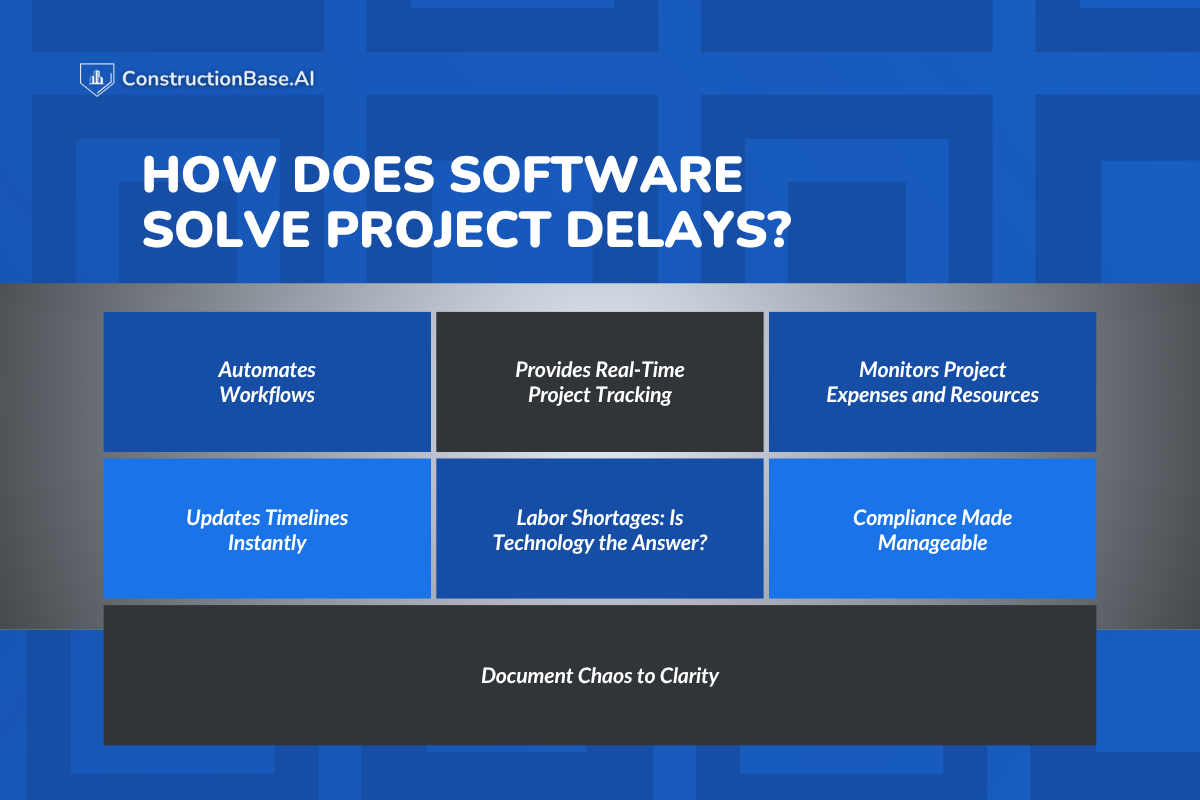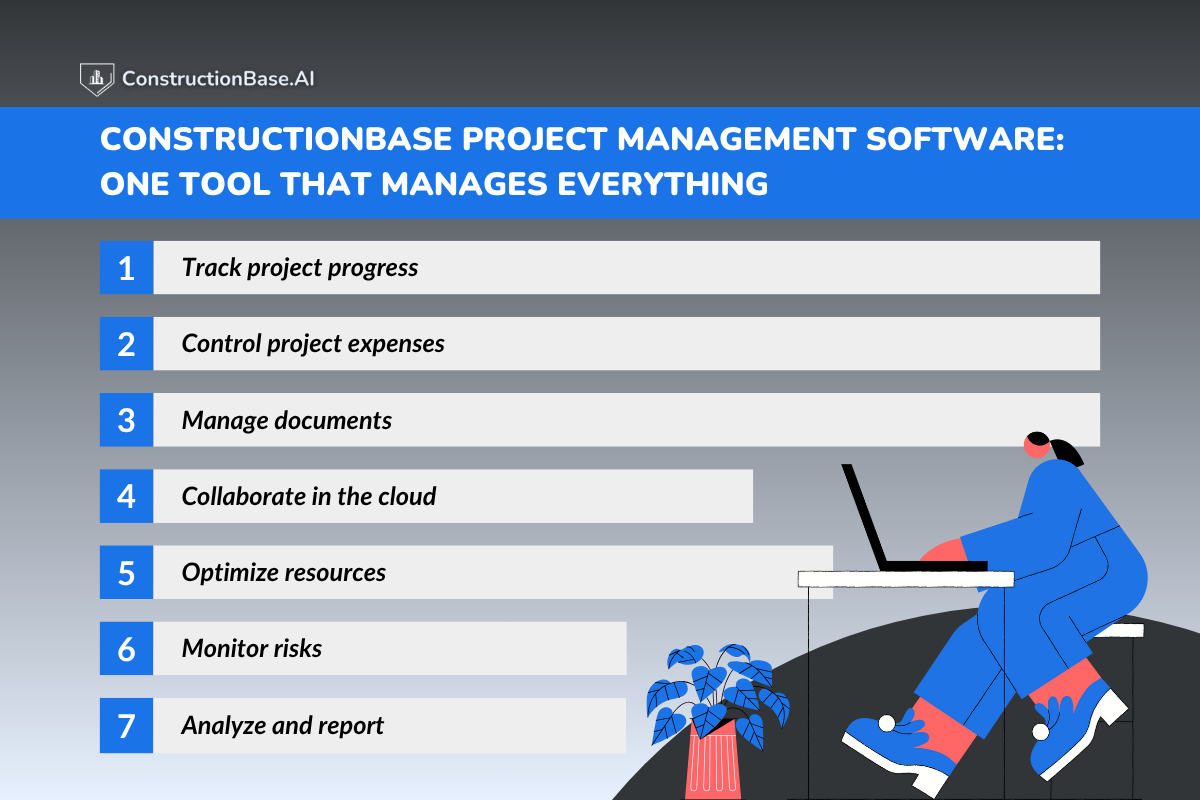Construction is no longer just about bricks, beams, and blueprints. In 2025, small businesses in the industry are under pressure from every angle: rising costs, stricter compliance, fewer skilled workers, and clients who expect faster delivery with no compromise on quality.
The reality? Many mid-sized construction teams are still trying to manage projects with spreadsheets, phone calls, and piles of paperwork.
That worked once, but today it’s like trying to build a skyscraper with a hammer and nails when the world is using advanced machinery.
Why Construction Project Management Software Is a Must-Have In 2025
For instance, you’re leading a project. The crew is waiting for instructions, materials are on site, but no one knows the latest change in the project timelines because the document got lost in someone’s inbox. The delay not only frustrates customers but also costs thousands in project expenses.
This isn’t an isolated problem; it’s what many small construction businesses and general contractors face daily.
That’s exactly what this blog will show you. We'll discuss why the best construction management software, with all the features, is no longer a luxury. It’s the glue that keeps everything, and everyone, together.
Key Takeaways:
- Labor shortages, complex compliance rules, and constant budget pressures are reshaping the construction industry.
- Manual methods can’t deliver the speed, accuracy, and transparency that customers demand.
- Cloud-based tools designed for construction firms help manage projects, track time, generate estimates, and integrate with other tools for seamless workflows.
- When the stakes are this high, having the right management software is like having a skilled foreman who never takes a day off.
What’s Holding Back Construction Projects Today?
Construction projects in 2025 are more complex than ever, and the challenges aren’t just on paper; they show up in the daily struggles of teams on-site and in the office. Even experienced managers can feel stretched thin when multiple issues pile up simultaneously.
1. The Labor Shortage Problem
- U.S. contractors need 439,000 new workers this year.
- Europe lags with labor productivity about 20% below other industries.
Impact: Fewer people are expected to do more work. Foremen juggle multiple sites, crews cover unfamiliar tasks, and project managers constantly chase updates instead of planning ahead.
Without digital tools to manage projects, track time, and monitor task progress, even small delays, like late material delivery or overlooked change orders, can ripple into bigger problems, affecting daily logs, timelines, project expenses, and client satisfaction.
Halfway through a project, you suddenly realize, oh, we really should have tracked this task better.
2. The Hidden Costs of Old-School Methods
Many firms still rely on spreadsheets, paper forms, and endless email threads. McKinsey reports 98% of construction projects face delays or cost overruns, often for predictable reasons:
- Poor planning: Schedules in your head or scattered spreadsheets lead to missed deadlines.
- Communication gaps: Field teams, office managers, and subcontractors working in silos cause missteps.
- Lost or outdated documents: Missing permits, expired plans, or misplaced contracts create chaos.
- Regulatory hurdles: One overlooked safety or environmental form can halt an entire project.
Consequences: Inadequate tools can severely impact decision-making.
- Rising project expenses.
- Reduced profits.
- Frustrated clients and damaged trust.
3. The Moments You Might Miss
The problem is often invisible until it’s too late:
- A document tucked away in someone’s inbox.
- A schedule change was not communicated to the field team.
- A small compliance step was forgotten.
All these small oversights can snowball into major delays and cost overruns.
Solution: Construction management software centralizes tasks, timelines, documents, and team collaboration, so missing a step doesn’t derail your project
Take a look at: Why Digital Tools Are Reshaping Construction in 2025
The Changing Face of Construction Management in 2025
The construction industry is in a digital shift. Just like architects replaced pencil drawings with CAD software, project managers are now moving from whiteboards to cloud versions of construction management software.
1. Rising Project Complexities and Tighter Deadlines
With multiple subcontractors, stricter inspection schedules, and complex supply chains, project timelines can shift by hours. Manual updates leave teams scrambling.
2. Labor Shortages and Productivity Pressures
Smaller crews mean each worker has to deliver more. In this case, software helps track time, allocate resources wisely, and prevent idle labor.
3. New Compliance & Safety Requirements
2025 brings stricter building codes, ESG mandates, and safety checks. Without proper documentation, projects risk delays, fines, or even shutdowns.
How Compliance and Regulations Are Stressing Firms Out
Think of compliance as a moving target; you may think you’ve hit it, but new requirements keep popping up, and missing one can shut down an entire project.
A real-world example: A U.S. construction firm lost nearly two months waiting for a missed inspection approval. The result? Lost revenue, frustrated clients, and higher project expenses.
With the right construction management software, you can:
- Generate reports automatically.
- Keep permits, safety logs, and compliance forms in one cloud version.
- Share records instantly with inspectors or clients.
- No more playing hide-and-seek with critical paperwork.
Why Young Project Teams Struggle Without Smart Tools
Let's take an example of a 28-year-old project manager handling three job sites at once. One team is in the field, another is working remotely, and clients are calling for updates. Without tools for team collaboration, task management, and document control, chaos is inevitable.
Software lets younger teams:
- Create tasks instantly and assign them across projects.
- Share real-time updates with field teams and contractors.
- Track progress through simple dashboard views.
It’s like upgrading from an old flip phone to a smartphone, and then you wonder how you ever managed without it.
What Is Construction Management Software Really Doing?
At its core, the best construction management software is designed to make your life easier by centralizing:
- Project planning and scheduling: Manage project timelines with precision.
- Document management: Store blueprints, contracts, and compliance forms in one place.
- Budgeting & job costing: Track project expenses and generate estimates accurately.
- Resource tracking: Know where your people, equipment, and materials are.
- Team collaboration: Keep contractors, subcontractors, and clients on the same page.
- Integration with other tools: Connect with ERP, accounting systems, or task management apps.
It’s not just software, it’s a digital control center for your communication and construction projects.
How Does Software Solve Project Delays?

Delays on construction projects often start small, such as a missed call, a late material delivery, or a forgotten approval. Left unchecked, these minor issues snowball into major setbacks.
Construction management software helps break this chain and keeps projects on track. Here’s how:
1. Automates Workflows
Tasks no longer get stuck waiting for approvals or follow-ups. Automation ensures every step moves forward, reducing bottlenecks and keeping your team productive.
2. Provides Real-Time Project Tracking
Get instant visibility into task progress, timelines, and potential roadblocks. Knowing where things stand lets managers intervene before delays escalate.
3. Monitors Project Expenses and Resources
Software tracks budgets, labor, and materials in real time. You can see how resources are allocated and prevent unnecessary spending, keeping project expenses under control.
4. Updates Timelines Instantly
Changes are reflected immediately across the team. Field crews, contractors, and managers all stay on the same page, preventing wasted hours and confusion on-site.
5. Labor Shortages: Is Technology the Answer?
Yes, while software can’t hire workers, it ensures small teams do more with less. Here's how:
- Optimized schedules mean no wasted shifts.
- Digital onboarding helps new hires ramp up quickly.
- Safety tracking reduces costly downtime.
6. Compliance Made Manageable
Forget paper binders. With document management and integration features, every permit and inspection is right at your fingertips.
7. Document Chaos to Clarity
Studies show workers spend 20% of their time just searching for information. A centralized cloud version means every stakeholder, contractor, client, or field team has what they need, when they need it.
By spotting problems early, construction management software saves money, reduces stress, and keeps projects moving smoothly. It’s like having a digital foreman who never sleeps.
Want to know strategies? Explore: 5 Strategies to Prevent Construction Project Delays
How Can Management Software Save Money on Every Project?
Budget overruns are one of the biggest headaches for construction companies, big or small. Construction management software helps you take control by centralizing financial tracking.
Here’s how it keeps costs in check:
- Real-Time Cost Visibility: See exactly where money is being spent on labor, materials, and equipment. No more surprises at the end of the month.
- Accurate Estimates: Generate estimates that reflect current market prices and project conditions, making bids more precise and competitive.
- Early Overrun Alerts: The software flags potential budget overruns before they spiral out of control, allowing managers to act quickly and avoid costly mistakes.
Even small construction businesses and mid-sized teams can protect profit margins by using software as a built-in financial watchdog, keeping projects on track and clients happy.
What Features Should a Modern Construction Software Offer in 2025?
Not all construction software is created equal. The best tools provide features that streamline every part of your project, from planning to completion.
A modern construction management platform should include:
1. End-to-End Project Tracking:
Get complete visibility into every project stage. Real-time dashboards help you monitor progress, milestones, and bottlenecks so your team can stay proactive instead of reactive.
2. Advanced Document Management:
Store and share blueprints, contracts, and permits securely in one cloud-based hub. Automatic version control ensures everyone always works on the latest version of the document.
3. Compliance-Ready Reporting:
Regulations and safety standards can change fast. Automated reporting tools help you stay compliant by generating up-to-date forms, inspection logs, and audit-ready records without extra paperwork.
4. Cloud Version:
No matter if you’re in the office or on-site, cloud-based access lets you view data, update progress, or approve documents on the go. It keeps your projects running smoothly — even when your team is spread across multiple locations.
5. Task Management:
Assign tasks, set priorities, and track progress in real time. Built-in alerts and reminders help ensure no step gets overlooked, keeping your projects on schedule and your teams accountable.
6. Team Collaboration & Integration:
A truly modern platform connects every department — project managers, engineers, accountants, and field teams — while integrating with tools like ERP, CRM, and accounting software for seamless workflow.
7. Time Tracking:
Monitor hours spent on each task to optimize productivity. Accurate time logs show how much effort each task takes. Use this data to balance workloads, identify productivity gaps, and improve project planning in the future.
8. Cost & Job Tracking:
Track expenses and job costs for tighter financial control. You get a clear picture of where every rupee or dollar goes. It also tracks change orders in real time to prevent overruns and improve profitability with every project.
With these features, teams, whether small, mid-sized, or large construction firms, can stay organized, reduce delays, and protect margins, all while delivering projects more efficiently.
Getting Started: Choosing the Right Solution for Your Team
Your unique needs matter. A small construction business won’t require the same setup as a large construction firm with enterprise resource planning (ERP).
When choosing:
- Focus on usability; if it’s too complex, your team won’t use it.
- Look for platforms that allow easy integration with tools you already use.
- Test with free trials or demos before committing.
- Train your teams so adoption doesn’t lag.
Also read: Implementing Construction Management Software: A Step-by-Step Guide
The Future of Construction Management: What’s Next After 2025
The construction industry is moving into a new era where technology will do more than support projects; it will actively drive them forward. Here are three key shifts to watch:
1. AI-Powered Forecasting
Instead of reacting to issues, AI will help predict them. By analyzing past data and real-time inputs, it can anticipate delays, flag potential risks, and provide more accurate cost estimates. This allows managers to take preventive action rather than scrambling to fix problems after they arise.
2. Connected Job Sites
IoT-enabled tools are transforming job sites into connected networks. Sensors on equipment track performance and maintenance needs, while safety devices monitor conditions and alert teams to hazards instantly. The result is safer operations, reduced downtime, and greater overall efficiency.
3. Data-Driven Decisions
Data will become the backbone of decision-making. With analytics dashboards, managers will have a clear picture of progress, budgets, and workforce performance. What once required lengthy reports and guesswork can now be assessed in minutes, enabling faster, smarter choices.
Firms that embrace these shifts early will gain a clear competitive edge, delivering projects faster, staying on budget, and reducing risks, while others play catch-up.
ConstructionBase Project Management Software: One Tool That Manages Everything

After exploring features like real-time scheduling, document management, budgeting, and team collaboration, it’s natural to ask: how do all these tools work together to actually solve your day-to-day problems? That’s where ConstructionBase steps in.
It’s designed with your challenges in mind, whether you’re leading a small construction team, managing a mid-sized firm, or juggling multiple projects as a general contractor.
Instead of switching between spreadsheets, emails, and disconnected apps, ConstructionBase centralizes everything into one platform, so nothing slips through the cracks.
Here’s how it helps you take control:
- Project Scheduling & tracking: See timelines, milestones, and task completion in real time. No more chasing updates or wondering what’s delayed.
- Control project expenses: Monitor budgets, compare estimates to actuals, and catch overruns early, protecting both profit and peace of mind.
- Manage documents: Blueprints, contracts, permits, and reports are stored securely and updated automatically, so everyone has the latest version.
- Collaborate in the cloud: Share updates, communicate with field teams, subcontractors, and clients instantly, keeping everyone aligned.
- Optimize resources: Allocate labor, equipment, and materials efficiently to avoid idle time or overbooking.
- Monitor risks: Identify potential problems before they become costly delays, with tools that track mitigation plans and safety checks.
- Analyze and report: Make data-driven decisions with real-time insights into project health, team performance, and financials.
Whether you’re managing one project or ten, ConstructionBase keeps small teams organized, reduces stress, and ensures your clients stay satisfied.
It’s not just software, it’s a digital partner that steps into your shoes, understanding the daily headaches of construction and helping you prevent small issues from snowballing.
Often, it’s the tools you didn’t realize you were missing that make the biggest difference.
Conclusion: Construction Success Depends on Smart Leadership
Managing construction projects in 2025 without modern tools is like building with half the crew and no blueprints; it’s possible, but painful.
Smart leadership means equipping your teams with the right platform. By choosing the best construction management software, you create clarity, control project expenses, and deliver consistent value to customers.
It’s not just about surviving in 2025; it’s also about thriving in it.
About ConstructionBase
ConstructionBase is a cloud-based management software designed for construction companies of all sizes. With features like project tracking, document management, integration with ERP, and team collaboration, it simplifies complex workflows and helps businesses stay profitable.
Take the first step: Get a demo of ConstructionBase today and see how much smoother your projects can run.
FAQs
1. What is construction management software?
It’s a tool that helps manage projects, track timelines, control expenses, and improve team collaboration in construction.
2. Why use the best construction management software over spreadsheets?
Unlike spreadsheets, it integrates tasks, costs, progress, and communication, making project management faster and error-free.
3. Can construction management software track project expenses?
Yes. It logs costs, monitors budgets, and compares planned vs. actual spending for better financial control.
4. How does it help with project progress and timelines?
It sets milestones, assigns tasks, and updates progress in real time, keeping projects on schedule.
5. Does it integrate with other tools?
Yes. The best construction management software connects with ERP, accounting, and time-tracking tools for smoother workflows.
Have questions or need personalized advice?
Talk to an Expert Today and let our construction specialists guide you to success.







